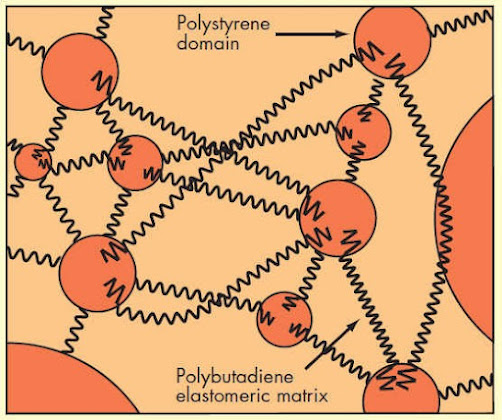Today's KNOWLEDGE Share:
UNDERSTANDING THE DIFFERENCE BETWEEN SBS & SEBS THERMOPLASTIC ELASTOMERS?
Over half a century ago, as I watched a fellow research student produce fascinating colours in his reaction vessel, as he prepared block copolymers using anionic polymerisation, little did I realise I was witnessing the dawn of a new class of materials —thermoplastic elastomers (TPE).
Using this system it was possible to construct precise polymer chains, with a sequence of styrene repeat units, tagged onto a sequence of butadiene repeat units and finished off with another block of styrene units. This gave a styrene-butadiene-styrene block copolymer (SBS).
It was soon discovered that, at ambient temperatures (below the glass transition temperature of polystyrene) the styrene block tails aggregate in clusters (domains) to act as rigid physical crosslinks. This maximises the high elastic properties of the butadiene block. At elevated temperatures the styrene domains disentangle and the polymer becomes a thermoplastic melt, suitable for extrusion and injection moulding.The elastic extension and recovery properties of SBS match those of conventional vulcanised elastomers. However, the advantage is that there is no ‘cure’ stage and process time and energy consumption are greatly reduced. Also SBS can be processed from solution.
The soft touch characteristics of SBS were soon exploited by designers, particularly in hand tools. Applications now stretch to toys, automotive trim, tubing, wire & cable, footwear and to adhesives, sealants and even bitumen additives.
However SBS has degradation issues at high temperatures and the butadiene content makes it prone to oxidation and weathering, without appropriate antioxidants. By converting the butadiene block to ethylene-butylene repeat units, SEBS thermoplastic elastomers have better thermal stability and better weathering resistance, without sacrificing too much in mechanical performance. SEBS is also steam sterilisable.
Trade Names:
SBS: Kraton D, Evoprene, Dryflex, Solprene, Europrene SOL T, K-Resin
SEBS: Kraton G, Evoprene G, Dryflex, Thermolast K, Europrene SOL TH
Source:Dr.Charlie Geddes from Hardiepolymers
Visit MY BLOG http://polymerguru.blogspot.com
#sebs #elastomers #tpe #polymerisation #kraton #butadiene #styrene #adhesives #toys #cables #thermalengineering





No comments:
Post a Comment